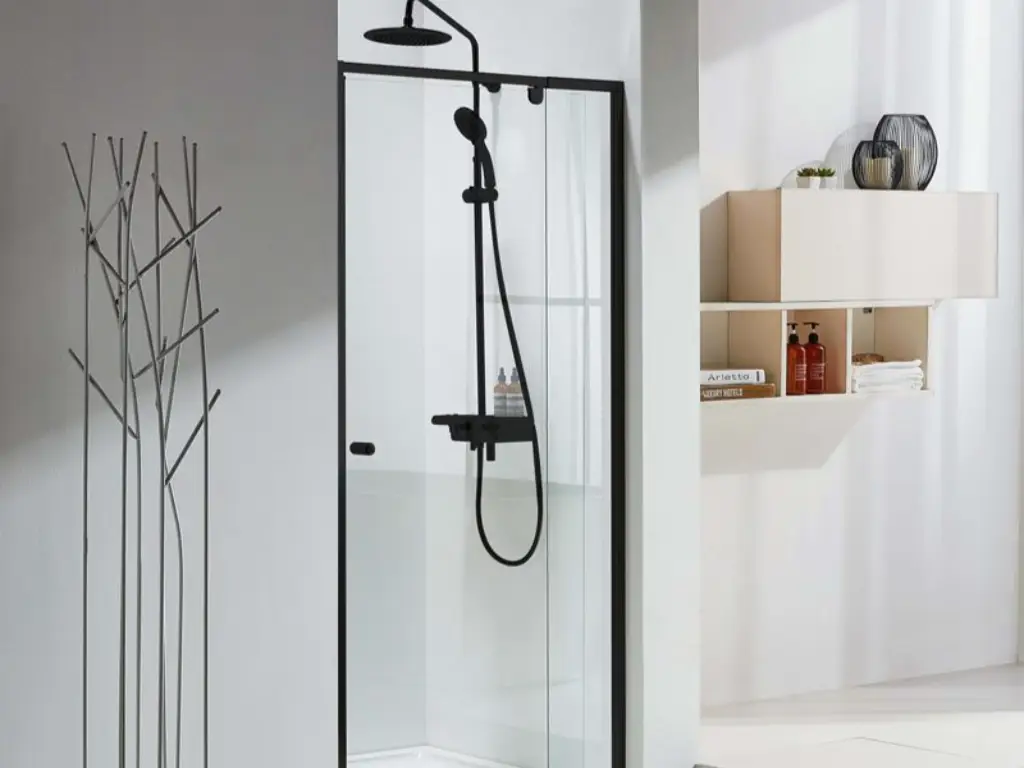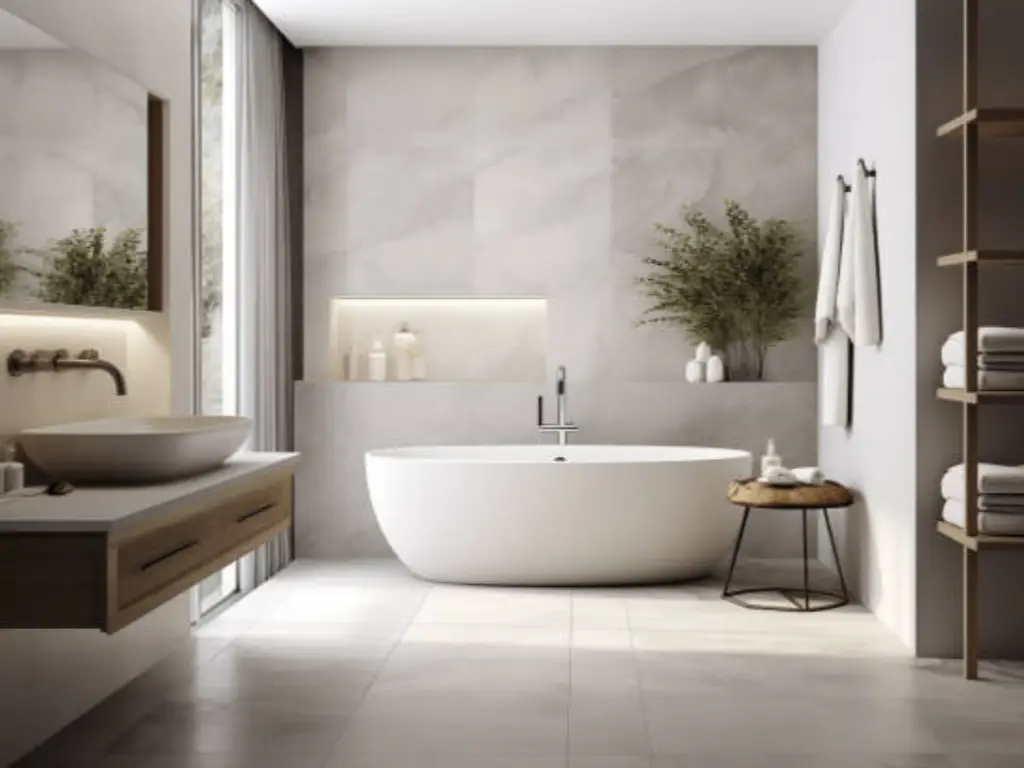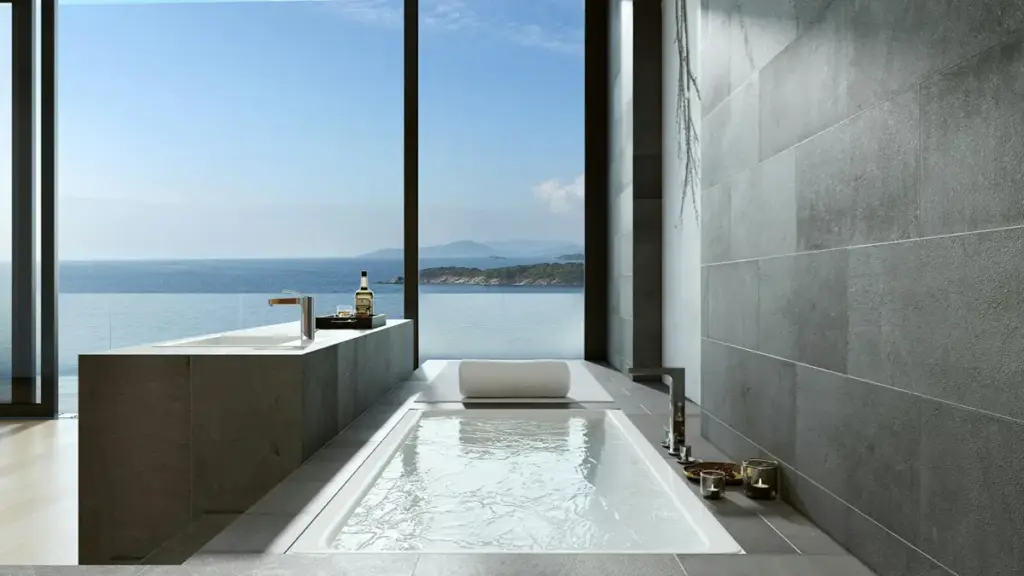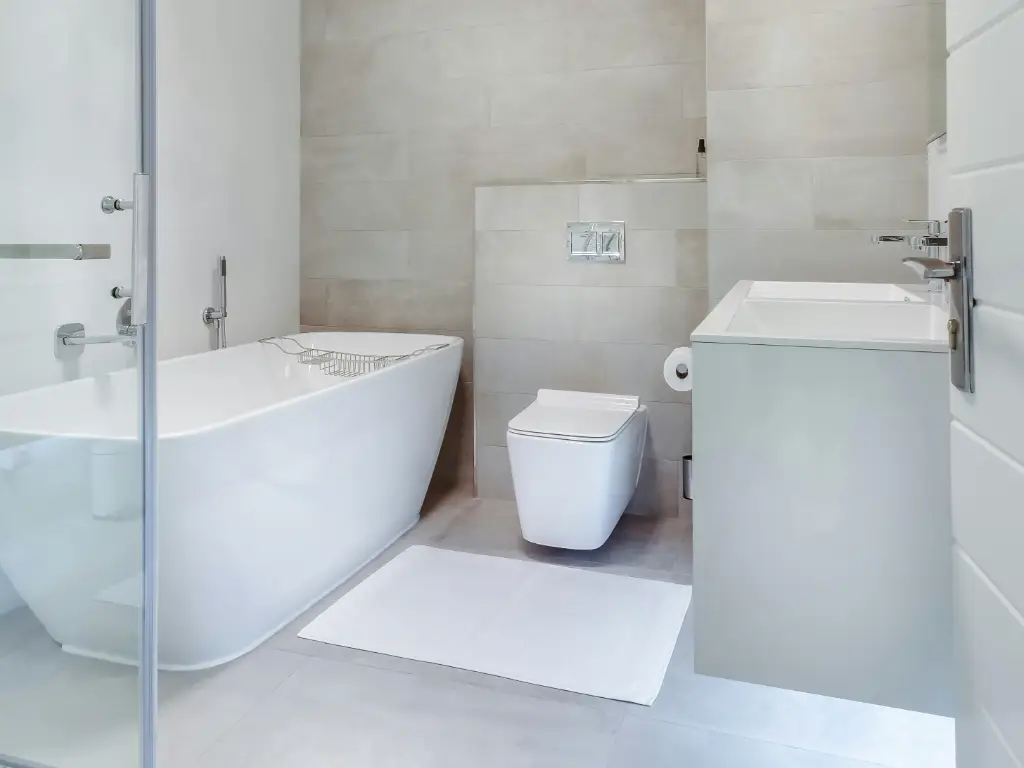เมื่อเลือกกระจกที่เหมาะกับประตูห้องอาบน้ำของคุณ, อาจรู้สึกเหมือนว่าคุณกำลังพยายามไขปริศนาที่คุณไม่รู้ว่ามีอยู่จริง. จะเลือกใช้กระจกเหล็กต่ำหรือกระจกใสมาตรฐาน? แต่ละตัวเลือกมีข้อดีและลักษณะเฉพาะของตัวเอง, แต่พวกมันจะซ้อนกันได้อย่างไร? มาเจาะลึกและสำรวจความแตกต่างที่สำคัญระหว่างกระจกที่มีเหล็กต่ำกับกระจกที่มีเหล็กต่ำ. กระจกใส, เพื่อให้คุณสามารถเลือกสิ่งที่ดีที่สุดสำหรับห้องน้ำของคุณได้.
แก้วเหล็กต่ำคืออะไร & กระบวนการผลิตของมัน?

แก้วที่มีเหล็กต่ำก็เหมือนกับแก้วที่มีธาตุเหล็กน้อยกว่ากระจกใสทั่วไป. เหตุใดสิ่งนี้จึงสำคัญ? เหล็กเป็นสาเหตุหลักที่อยู่เบื้องหลังสีเขียวอ่อนที่คุณเห็นในกระจกธรรมดา, เห็นได้ชัดเจนเป็นพิเศษตามขอบ. กระจกเหล็กต่ำช่วยลดสิ่งนี้, ส่งผลให้มีความชัดเจนมากขึ้น, มีลักษณะเกือบเหมือนคริสตัล.
กระบวนการผลิต เกี่ยวข้องกับการกำจัดปริมาณธาตุเหล็กส่วนใหญ่ในระหว่างการผลิต. สิ่งนี้จะทำให้เกิดความบริสุทธิ์มากขึ้น, ผลิตภัณฑ์ที่ชัดเจนเป็นพิเศษ, มักใช้ในการออกแบบสถาปัตยกรรมระดับไฮเอนด์หรือในสถานที่ที่ความชัดเจนมีความสำคัญจริงๆ, เหมือนมีหน้าร้าน, กรณีแสดง, และ—ใช่, คุณเดามัน-ประตูห้องอาบน้ำ.
กระจกใสคืออะไร & กระบวนการผลิตของมัน?
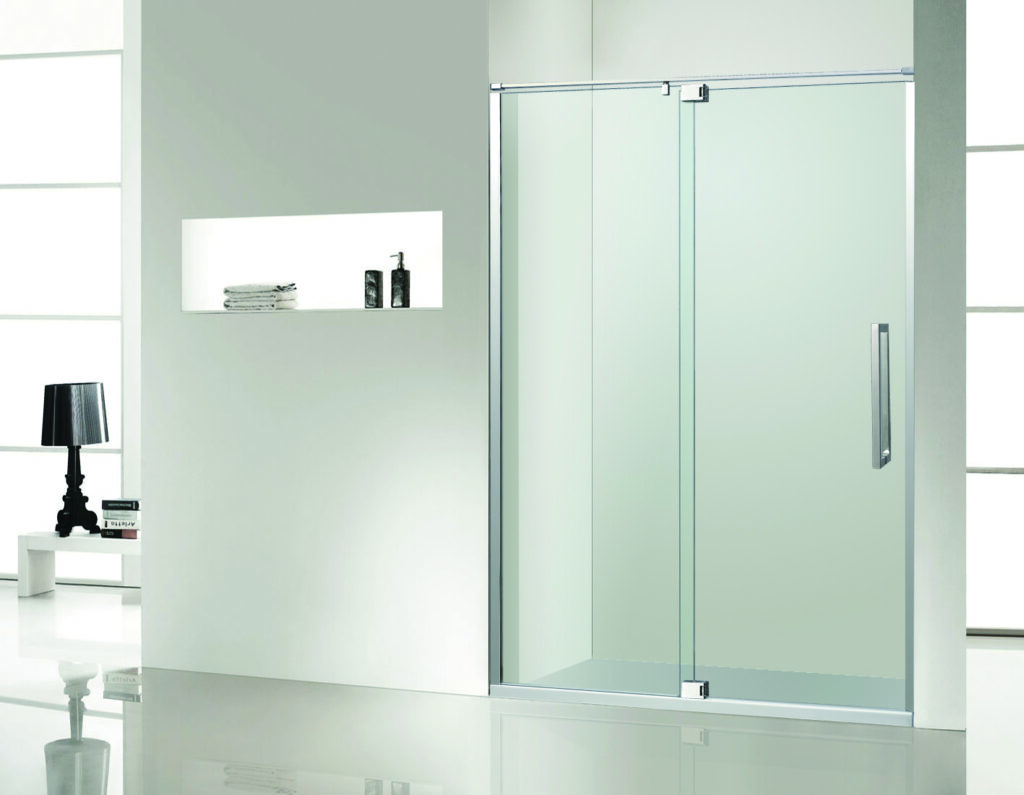
กระจกใส, หรือกระจกมาตรฐาน, คือสิ่งที่คุณน่าจะคุ้นเคยมากที่สุด. มีมาโดยตลอดและเป็นตัวเลือกสำหรับ windows, กรอบรูป, และ, แน่นอน, ประตูห้องอาบน้ำ. ในระหว่างการผลิต, เหล็กเป็นส่วนประกอบตามธรรมชาติ, ซึ่งทิ้งโทนสีเขียวเล็กน้อยที่เราเคยเห็นมา.
แม้ว่าโดยทั่วไปแล้วโทนสีจะไม่ส่งผลต่อการใช้กระจกของเรา, มันอาจเป็นตัวทำลายได้เมื่อความแม่นยำด้านสุนทรียะเป็นสิ่งสำคัญ. นิ่ง, กระจกใสใช้งานได้จริง, ซื้อได้, และสมบูรณ์แบบสำหรับการใช้งานในชีวิตประจำวันส่วนใหญ่.
แก้วเหล็กต่ำเทียบกับ. กระจกใส: ข้อดีข้อเสีย
| คุณสมบัติ | แก้วเหล็กต่ำ | กระจกใสมาตรฐาน |
| โทนสี | น้อยที่สุด, คริสตัลเคลียร์ | สีเขียวอ่อนที่เห็นได้ชัดเจน |
| การส่งผ่านแสง | สูงกว่า | ต่ำกว่า |
| ค่าใช้จ่าย | สูงกว่า | ต่ำกว่า |
| ความทน | คล้ายกัน | คล้ายกัน |
| การซ่อมบำรุง | ง่ายขึ้น | มีแนวโน้มที่จะมีคราบน้ำ |
| การใช้งานในอุดมคติ | ไม่มีกรอบ, ห้องน้ำสมัยใหม่ | โครงการที่คุ้มค่า |
ข้อดี & ข้อเสียของกระจกเหล็กต่ำ
ข้อดี:
- ความชัดเจนไร้ที่ติ, ให้รูปลักษณ์โฉบเฉี่ยวและทันสมัย.
- แทบมองไม่เห็น, ช่วยเพิ่มการมองเห็นสีและดีไซน์ด้านหลังกระจก.
- เหมาะสำหรับห้องอาบน้ำฝักบัวที่ปูกระเบื้องอย่างสวยงามและการออกแบบห้องน้ำระดับไฮเอนด์.
ข้อเสีย:
- ต้นทุนสูงกว่าเมื่อเทียบกับกระจกใสมาตรฐาน.
- ยิ่งกระจกใส., ยิ่งมีรอยเปื้อนหรือคราบน้ำที่เห็นได้ชัดเจนมากขึ้นเท่านั้น.
- อาจต้องทำความสะอาดบ่อยขึ้นเพื่อรักษารูปลักษณ์เดิม.
ข้อดี & ข้อเสียของกระจกใส
ข้อดี:
- เชื่อถือได้และราคาไม่แพง, เหมาะสมกับงบประมาณส่วนใหญ่.
- โทนสีเขียวมักจะมองไม่เห็น เว้นแต่จะเปรียบเทียบกับกระจกที่มีเหล็กต่ำหรือวางไว้บนพื้นหลังที่มีสีอ่อน.
- ใช้งานได้จริงและทนทาน, ทำให้เป็นตัวเลือกที่ดีสำหรับการใช้ชีวิตประจำวัน.
ข้อเสีย:
- สีเขียวอาจเบี่ยงเบนไปจากการออกแบบโดยรวม, โดยเฉพาะในห้องน้ำระดับไฮเอนด์หรือมินิมอลลิสต์.
- อาจจะไม่ได้ให้ความหรูหรา, รูปลักษณ์ทันสมัยที่กระจกเหล็กต่ำนำเสนอ.
แก้วเหล็กต่ำเทียบกับ. กระจกใส: ความชัดเจนของภาพและสุนทรียภาพ
นี่คือสิ่งที่: กระจกเหล็กต่ำคือสิ่งสำคัญในเรื่องของความชัดเจน. มันมี มุมมองที่คมชัด, เกือบจะเหมือนกับการมองผ่านอากาศ. เหมาะสำหรับห้องน้ำดีไซน์เรียบง่ายหรือทันสมัยที่คุณต้องการความสะอาด, ดูคมชัด. ในทางกลับกัน, กระจกใสให้โทนสีเขียว, เห็นได้ชัดเจนที่สุดที่ขอบ, ซึ่งอาจขัดแย้งกับความสวยงามโดยรวมของพื้นที่ของคุณหรือไม่ก็ได้.
ลองคิดดูสิ ถ้าคุณสวมแว่นกันแดดแบบมีสี, สีจะดูไม่ถูกต้องนัก. นั่นมันกระจกใส. แก้วเหล็กต่ำ? มันเหมือนกับการถอดแว่นกันแดดออกแล้วมองเห็นทุกอย่างตามที่เป็นอยู่, ในรูปแบบที่แท้จริง. ดังนั้น, หากคุณชื่นชอบภาพที่มีความแม่นยำและคมชัด, แก้วเหล็กต่ำชนะรอบนี้.
แก้วเหล็กต่ำเทียบกับ. กระจกใส: การส่งผ่านแสง
นี่เป็นรายละเอียดลับๆ ที่คนส่วนใหญ่ไม่ได้นึกถึง: ปริมาณแสงที่ผ่านกระจก. แก้วเหล็กต่ำ, โดยมีปริมาณธาตุเหล็กลดลง, ช่วยให้แสงธรรมชาติส่องผ่านได้มากขึ้นโดยไม่มีสิ่งกีดขวาง. ทำให้ห้องน้ำของคุณรู้สึกสว่างและเปิดกว้างมากขึ้น, ซึ่งสามารถพลิกเกมได้ในพื้นที่ขนาดเล็ก.
กระจกใส, ในทางกลับกัน, บังแสงบางส่วนเล็กน้อยเนื่องจากมีธาตุเหล็ก. มันไม่น่าทึ่ง, แต่เป็นสิ่งที่ต้องคำนึงถึงหากคุณพยายามเพิ่มแสงให้สูงสุด.
แก้วเหล็กต่ำเทียบกับ. กระจกใส: ค่าใช้จ่าย
ตอนนี้สำหรับช้างในห้อง - ราคา. กระจกเหล็กต่ำมีแนวโน้มที่จะมีราคาแพงกว่ากระจกใส. ทำไม? เนื่องจากเป็นผลิตภัณฑ์ระดับพรีเมี่ยมที่ให้ความคมชัดและความสวยงามที่เหนือกว่า. แต่มันคุ้มกับเงินที่เสียไปหรือเปล่า?
หากคุณกำลังออกแบบห้องน้ำระดับไฮเอนด์และต้องการให้ทุกรายละเอียดดูสะอาดตา, แก้วเหล็กต่ำอาจคุ้มค่ากับการใช้จ่าย. แต่ถ้าคุณมีงบจำกัดหรือไม่สนใจโทนสีเขียว, กระจกใสเป็นตัวเลือกที่ใช้งานได้จริงและดึงดูดสายตาสำหรับประตูห้องอาบน้ำส่วนใหญ่.
แก้วเหล็กต่ำเทียบกับ. กระจกใสสำหรับประตูห้องอาบน้ำ
เมื่อพูดถึงประตูห้องอาบน้ำ, ทั้งกระจกเหล็กต่ำและกระจกใสก็มีข้อดีเหมือนกัน. ประตูห้องอาบน้ำกระจกเหล็กเตี้ยเหมาะอย่างยิ่งหากคุณต้องการจัดแสดงงานกระเบื้องที่สลับซับซ้อน หรือเพียงต้องการให้ฝักบัวของคุณผสมผสานเข้ากับส่วนอื่นๆ ของห้องน้ำได้อย่างลงตัว. ให้ความรู้สึกโล่งและสดใส, เพิ่มความหรูหรา.
ประตูห้องอาบน้ำกระจกใส, ในขณะที่ราคาไม่แพงกว่า, ยังคงเป็นตัวเลือกที่มั่นคง. มันอาจไม่ทำให้คุณดูไร้ที่ติ, แต่มันก็ทนทาน, ติดตั้งง่าย, และทำงานให้เสร็จโดยไม่ทำลายธนาคาร.
ตัวเลือกความหนาของกระจกประตูห้องอาบน้ำ
แนะนำความหนาเท่าไหร่สำหรับประตูห้องอาบน้ำ?
ความหนาของกระจกประตูห้องอาบน้ำของคุณเป็นอีกสิ่งหนึ่งที่ต้องพิจารณา. ประตูห้องอาบน้ำส่วนใหญ่มีความหนา 3/8 นิ้วหรือ 1/2 นิ้ว. ยิ่งกระจกหนาเท่าไร, ยิ่งแข็งแกร่ง (และหนักกว่า) ประตูจะรู้สึก.
3/8-นิ้วเทียบกับ. 1/2-ความหนาของกระจกนิ้ว
ดังนั้น, คุณควรเลือกอันไหน? 3/8-กระจกขนาดนิ้วเป็นกระจกที่นิยมใช้กันมากที่สุดและทนทานเพียงพอสำหรับประตูห้องอาบน้ำส่วนใหญ่. อย่างไรก็ตาม, หากคุณต้องการสิ่งที่สำคัญมากขึ้น, ความรู้สึกระดับพรีเมียม, 1/2-กระจกขนาดนิ้วมีความทนทานและน้ำหนักเป็นพิเศษ, ทำให้รู้สึกหรูหราและมั่นคงยิ่งขึ้น.
ความหนาส่งผลต่อกระจกทั้งสองประเภทอย่างไร
กระจกที่หนาขึ้นมีแนวโน้มที่จะทำให้ทั้งเหล็กต่ำและกระจกใสให้ความรู้สึกแข็งแกร่งมากขึ้น, โดยไม่คำนึงถึงประเภทที่คุณเลือก. มันอยู่ที่ว่าคุณต้องการให้ประตูห้องอาบน้ำสร้างผลกระทบต่อพื้นที่มากแค่ไหน.
การเลือกกระจกให้เหมาะกับประตูห้องอาบน้ำของคุณ
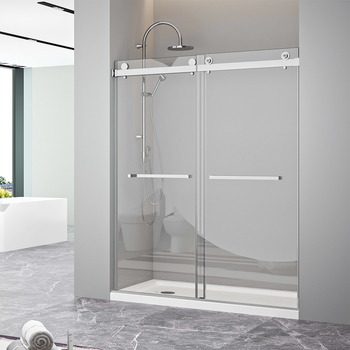
เมื่อถึงเวลาต้องตัดสินใจเลือก, ทุกอย่างขึ้นอยู่กับลำดับความสำคัญของคุณ. หากความสวยงาม, ความชัดเจน, และรูปลักษณ์ระดับไฮเอนด์ก็มีความสำคัญต่อคุณ, และงบประมาณไม่ใช่ประเด็นสำคัญ, ถ้าอย่างนั้นแก้วเหล็กต่ำก็เป็นหนทางไป. อย่างไรก็ตาม, หากคุณกำลังมองหาบางสิ่งที่ราคาไม่แพงและใช้งานได้ดีกว่า, กระจกใสจะยังคงให้รูปลักษณ์ที่สวยงาม, โซลูชั่นที่ยาวนานสำหรับประตูห้องอาบน้ำของคุณ.
บทสรุป
ในที่สุด, การตัดสินใจระหว่างกระจกเหล็กต่ำกับกระจกใสขึ้นอยู่กับความชอบส่วนตัวของคุณ, งบประมาณ, และคุณต้องการให้การอาบน้ำของคุณดูเป็นอย่างไร. กระจกเหล็กต่ำให้ความชัดเจนที่ไม่มีใครเทียบและความสวยงามทันสมัย, ในขณะที่กระจกใสยังคงความน่าเชื่อถือ, ตัวเลือกที่คุ้มค่า. ดังนั้น, ไม่ว่าคุณจะออกไปข้างนอกในห้องน้ำที่หรูหราหรือเก็บของที่มีประโยชน์, มีกระจกที่เหมาะกับสไตล์ของคุณ.
คำถามที่พบบ่อย
1. แก้วเหล็กต่ำคืออะไร, และทำไมถึงใช้กับประตูห้องอาบน้ำ?
แก้วเหล็กต่ำเป็นแก้วชนิดหนึ่งที่มีปริมาณธาตุเหล็กลดลง, ส่งผลให้มีความชัดเจนมากขึ้น, ความโปร่งใสเหมือนคริสตัล. นิยมใช้กับประตูห้องอาบน้ำเพื่อความเงางาม, รูปลักษณ์ที่ทันสมัย.
2. กระจกเหล็กต่ำมีข้อเสียอะไรบ้าง?
ข้อเสียเปรียบหลักของกระจกเหล็กต่ำคือต้นทุนที่สูงกว่าเมื่อเทียบกับกระจกใสมาตรฐาน. นอกจากนี้, อาจแสดงจุดน้ำได้ชัดเจนยิ่งขึ้นเนื่องจากมีความโปร่งใส.
3. ประตูห้องอาบน้ำกระจกใสมีโทนสีเขียวที่เห็นได้ชัดเจนหรือไม่?
ใช่, กระจกใสประกอบด้วยเหล็กธรรมชาติ, ซึ่งทำให้มีสีเขียวเล็กน้อย. โทนสีนี้จะสังเกตเห็นได้ชัดเจนกว่าตามขอบหรือในชิ้นกระจกที่หนากว่า.
4. เป็นกระจกเหล็กเตี้ยคุ้มค่ากับราคาเพิ่มสำหรับประตูห้องอาบน้ำ?
หากความชัดเจนและความสวยงามระดับสูงเป็นสิ่งสำคัญสำหรับคุณ, กระจกเหล็กต่ำอาจคุ้มค่ากับค่าใช้จ่ายเพิ่มเติม. อย่างไรก็ตาม, กระจกใสยังคงใช้งานได้ดีและราคาไม่แพงสำหรับการใช้งานส่วนใหญ่.
5. ความหนาใดดีที่สุดสำหรับประตูห้องอาบน้ำ: 3/8-กระจกขนาด 1/2 นิ้วหรือ 1/2 นิ้ว?
3/8-กระจกขนาดนิ้วเป็นกระจกที่นิยมใช้กันมากที่สุดและมีความทนทานที่ดี. อย่างไรก็ตาม, 1/2-กระจกขนาดนิ้วให้ความรู้สึกพรีเมี่ยมยิ่งขึ้น, ทำให้ประตูแข็งแรงและหนักขึ้น.

